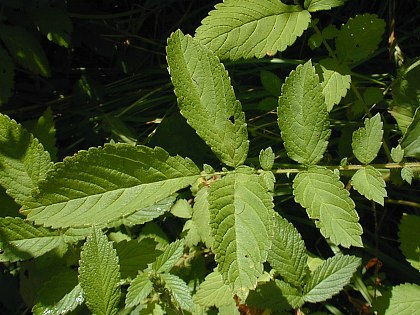Description: This herbaceous perennial plant is about 1½–2½' tall and unbranched or sparingly so. The lower central stem has long ascending hairs and short pubescent hairs, while the upper stem(s) has only short pubescent hairs; this stem (or stems) is terete (round in cross-section) and rather stout. The alternate leaves are odd-pinnate with 5-9 primary leaflets. Between adjacent pairs of primary leaflets, there is a single pair of secondary leaflets along the stalk (or rachis) of each compound leaf. The primary leaflets are up to 3" long and 1½" across; they are ovate, oval-ovate, or oblong-ovate in shape. The upper surface of each primary leaflet is dull green, hairless, and conspicuously veined; its margins are coarsely toothed. The lower surface of each primary leaflet is whitish green and pubescent. The secondary leaflets are much smaller in size than the primary leaflets, otherwise they share many of the same characteristics. The stalk (or rachis) of each compound leaf is light green and pubescent or hairy. At the base of each compound leaf, there is a pair of leafy stipules about 2/3" (16 mm.) long. The stipules are coarsely toothed or cleft with pointed lobes. The upper stem(s) terminates in a spike-like raceme of flowers up to 1' long. The flowers are sparsely distributed along the stalk of the raceme. Normally, this raceme is straight and erect, but sometimes it leans over to one side or curves slightly. The stalk of the raceme is covered with short pubescent hairs. Each flower is up to 1/3" (8 mm.) across; it has 5 yellow petals, 5 green sepals, and about 10 stamens. The petals are oblong in shape and spread outward while the flower is in bloom.

The blooming
period occurs from mid-summer to early fall and lasts about 1 month.
Each flower is replaced by a green fruit that is broadly conical toward
the bottom and pointed-turbinate toward the top. Along the upper rim of
each fruit, there is a fringe of short hooked prickles. The fruits turn
brown when they become mature. The root system is rhizomatous and
fibrous.
Cultivation:
The preference is partial sun, moist to dry conditions, and a
reasonably fertile soil containing some loam.
Range & Habitat:
The native Downy Agrimony is occasional to locally common in central
and northern
Illinois, but it is less common or absent in southern Illinois (see Distribution
Map). Habitats include open deciduous woodlands, savannas,
thickets, small meadows in wooded areas, areas along woodland paths,
and powerline clearances in wooded areas. Disturbance is beneficial if
it reduces excessive shade from trees and other woody vegetation.

Faunal
Associations:
Little information is currently available about floral-faunal
relationships for this species. According to Robertson (1929), Halictid
bees collect pollen or suck nectar from the flowers. The hooked
bristles of the fruits can cling to the fur of animals, the feathers of
birds, or the clothing of humans. In this manner, the seeds can be
transported for considerable distances.
Photographic Location:
A powerline clearance at Busey Woods in Urbana, Illinois.
Comments:
Downy Agrimony is one of several Agrimonia spp. in
Illinois. It can be distinguished from these other species by the short
pubescent hairs on the stalks of its racemes; the other species have
floral stalks that are long hairy or hairless. The leaves and leaflets
of these Agrimonia spp. are rather similar to each
other, except for Agrimonia parviflora (Swamp
Agrimony). This latter species has more primary leaflets per compound
leaf (about 11-17) and its primary leaflets are more narrow in shape.
Swamp Agrimony prefers habitats that are more moist and sunny than
other Agrimonia spp. in Illinois. Agrimony species
are easily distinguished from other plants by the small secondary
leaflets on their compound leaves; other plants with pinnate leaves
typically lack such leaflets. Another common name of Agrimonia
pubescens is Soft Agrimony.